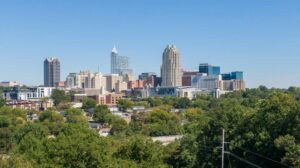 Recently, the most prominent national news story to come out of North Carolina was probably the splashy return of Cam Newton to the Panthers. But for those who actually live here, in cities like Charlotte, Raleigh, and across the Tarheel State, the explosion of property development is at the top of the page. Pretty much wherever you look, there is some new project, construction, or development. The development of additional high rises in Charlotte’s South End is the kind of project that is hard to miss, but there is a lot more going on in the property development world here in North Carolina, and you don’t have to look too deep to find it.
Recently, the most prominent national news story to come out of North Carolina was probably the splashy return of Cam Newton to the Panthers. But for those who actually live here, in cities like Charlotte, Raleigh, and across the Tarheel State, the explosion of property development is at the top of the page. Pretty much wherever you look, there is some new project, construction, or development. The development of additional high rises in Charlotte’s South End is the kind of project that is hard to miss, but there is a lot more going on in the property development world here in North Carolina, and you don’t have to look too deep to find it.From Bowling Green to Mooresville
Holley Performance Products, a nationally renowned maker of performance automotive parts, has initiated the construction of a new headquarters in Mooresville. At the cost of more than $12 million, this new facility will become the east coast headquarters for HPP, replacing their old facility in Kentucky. This isn’t the largest construction project in the state, but it is delivering something badly needed in Mooreville and other North Carolina cities and towns: Jobs. The facility is expected to provide an average annual salary of about $40,000 to more than one hundred employees. North Carolina is attractive as a destination for relocating companies, but that is also true in the residential real estate and property development sectors.
Building Back Greener
The Biden administration seems hell-bent on keeping the spigots of federal cash wide open, so it should be no surprise that North Carolina in general, and the cities of Raleigh and Charlotte in particular, are looking to cash in. Some are quick to point to inflation risks, but there is a lot of money at stake, so investors are keen to take advantage and get a bite of the pie. Since much of the spending targets green initiatives and creating green spaces for the community, even skeptics are listening and looking for opportunities. The feds say that North Carolina experienced 42 extreme weather events in the last decade, with a price tag of more than $50 billion. So, the Build Back Better framework will provide plenty of money for developing properties, buildings, and other sectors, guided by a vision of clean energy, increased local manufacturing, and conservation, all while seeking a substantial reduction in greenhouse gas emissions.
No One Left Behind
Now, perhaps more than ever, property development is viewed through the lens of race. A recent report discussed the devaluation of assets in Black neighborhoods. The NY Times explored the issue further, zeroing in on the fact that the benefits of homeownership are not enjoyed equally along racial lines. Accordingly, there is an increased sense of urgency to temper the development of ultra-luxury high rises and even more modest accommodations like mid-rise residential towers, along with opportunities for affordable housing loans, even as residential home sale prices in areas like Charlotte continue to increase.
